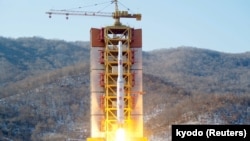North Korea’s latest long-range rocket launch is raising concerns in the United States and its allies that the communist country is moving forward with its ballistic missile program.
On Sunday, Pyongyang fired a long-range rocket from its west coast rocket launch site in Tongchang-ri. North Korea’s state television said the launch ordered by the country’s leader Kim Jong Un was a “complete success,” and that Pyongyang will continue to conduct the launches.
Pyongyang insists the launch is a peaceful space mission. But its apparent noncompliance with international obligations raises questions about the purpose of the mission.
When Pyongyang notified the International Telecommunication Union, a U.N. agency that promotes international cooperation in assigning satellite orbits, of the latest launch last week, it said the move was part of its effort to launch an “Earth observation satellite.”
Controversial mission
Pyongyang, however, failed to provide some “mandatory information” required for the launch in its notification, according to the agency.
Sanjay Acharya, ITU’s chief of media relations and public information, told VOA his agency had asked Pyongyang to provide the missing information, but Pyongyang proceeded with the launch without providing the information.
Pyongyang’s long-range rocket launch drew wide international attention in December 2012, when the country succeeded in putting into orbit a satellite for the first time. A satellite launched at the time is believed to be in orbit, although whether it is functioning remains unclear.
“I have not heard of anyone who has picked up radio signals from their satellite. My guess is that if that satellite worked at all, it didn’t work very long,” said Jonathan McDowell at the Harvard-Smithsonian Center for Astrophysics, referring to the satellite that Pyongyang launched in 2012.
Cover for missile test
Many Western observers suspect Pyongyang is trying to advance its ballistic missile technology, noting the technology used to put a satellite into space also could be used to deliver a nuclear warhead.
U.S. military analysts say that whether Pyongyang has the capability to fire an intercontinental ballistic missile that could reach the U.S. mainland is Washington’s primary concern. While many of them believe Pyongyang needs more time to reach full ICBM capability, some say Pyongyang might already have the ability to strike some parts of the U.S mainland.
Bruce Bechtol, a professor at Angelo State University in Texas, said the 2012 launch showed Pyongyang had “the capability of hitting Alaska, Hawaii, or parts of the West Coast of the United States.”
Strong condemnation
Washington condemned Sunday’s launch and stepped up diplomacy to take action against Pyongyang.
The U.S. State Department said Secretary of State John Kerry spoke separately on Sunday by phone with his counterparts in South Korea and Japan. Kerry called the launch a “violation of multiple U.N. Security Council Resolutions that threatened international peace and security” and “emphasized the importance of a united international response to North Korea’s provocations, including through a strong U.N. Security Council resolution,” said State Department spokesman John Kirby in a statement.
The U.N. Security Council on Sunday vowed to “adopt expeditiously a new Security Council resolution.”
The latest move marked Pyongyang’s sixth long-range rocket launch since 1998. The launch followed the country’s fourth nuclear test last month.
U.N. sanctions ban Pyongyang from conducting nuclear tests or any launches using ballistic missile technology.








